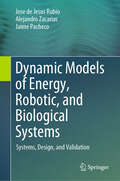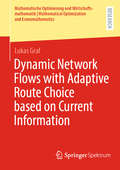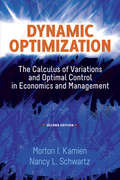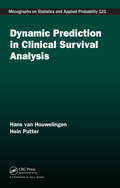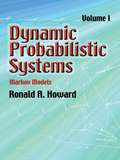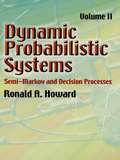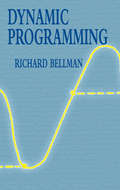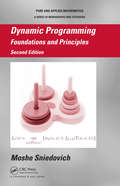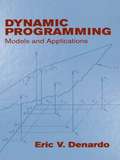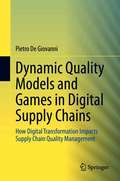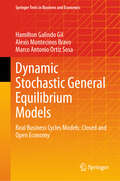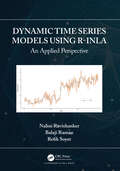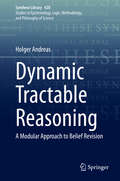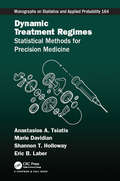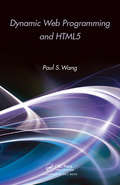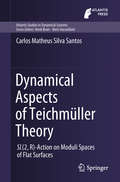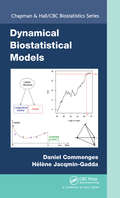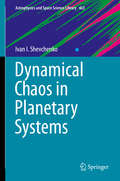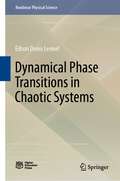- Table View
- List View
Dynamic Models for Volatility and Heavy Tails
by Andrew C. HarveyThe volatility of financial returns changes over time and, for the last thirty years, Generalized Autoregressive Conditional Heteroscedasticity (GARCH) models have provided the principal means of analyzing, modeling, and monitoring such changes. Taking into account that financial returns typically exhibit heavy tails - that is, extreme values can occur from time to time - Andrew Harvey's new book shows how a small but radical change in the way GARCH models are formulated leads to a resolution of many of the theoretical problems inherent in the statistical theory. The approach can also be applied to other aspects of volatility, such as those arising from data on the range of returns and the time between trades. Furthermore, the more general class of Dynamic Conditional Score models extends to robust modeling of outliers in the levels of time series and to the treatment of time-varying relationships. As such, there are applications not only to financial data but also to macroeconomic time series and to time series in other disciplines. The statistical theory draws on basic principles of maximum likelihood estimation and, by doing so, leads to an elegant and unified treatment of nonlinear time-series modeling. The practical value of the proposed models is illustrated by fitting them to real data sets.
Dynamic Models of Energy, Robotic, and Biological Systems: Systems, Design, and Validation
by Jaime Pacheco Jose de Rubio Alejandro ZacariasDynamic models are essential for understanding the system dynamics. It is of importance because one mistake in experiments could cause accidents or damages, while one mistake in the simulation of dynamic models could cause nothing. Each system has a different dynamic model; hence, this book presents the designs of 10 dynamic models which are mainly classified in two ways. The first kind of dynamic models are mainly obtained by the Euler Lagrange method and described by differential equations. The second kind of dynamic models are mainly obtained by the neural networks and described by difference equations. Topics and features: Contains the dynamic models of energy systems Derives dynamic models of energy systems by the Euler Lagrange method Includes the dynamic models of robotic systems Contains the dynamic models of biological systems Derives dynamic models of robotic systems by the Euler Lagrange method Obtains dynamic models of biological systems by neural networks This book is expected to be used primary by researchers and secondary by students and in the areas of control, robotics, energy, biological, mechanical, mechatronics, and computing systems. Jose de Jesus Rubio, Alejandro Zacarias, and Jaime Pacheco are full Professors affiliated with the ESIME Azcapotzalco, Instituto Politécnico Nacional, Sección de Estudios de Posgrado e Investigación, Ciudad de México, México.
Dynamic Network Flows with Adaptive Route Choice based on Current Information (Mathematische Optimierung und Wirtschaftsmathematik | Mathematical Optimization and Economathematics)
by Lukas GrafIn this book Lukas Graf studies dynamic network flows which are a model for individual car traffic in road networks. It is assumed that drivers choose their routes based on information about the current state of the network in such a way as to selfishly minimize their own arrival time at their destination. Whilst on their journey the drivers adapt their current route choices based on the changing state of the network. A dynamic flow wherein every (infinitesimally small) flow particle behaves in this way is then called an instantaneous dynamic equilibrium. After giving a mathematically precise definition of this equilibrium concept the author shows existence of those equilibrium flows, studies their computational complexity and derives bounds on their quality.
Dynamic Network Representation Based on Latent Factorization of Tensors (SpringerBriefs in Computer Science)
by Hao Wu Xin Luo Xuke WuA dynamic network is frequently encountered in various real industrial applications, such as the Internet of Things. It is composed of numerous nodes and large-scale dynamic real-time interactions among them, where each node indicates a specified entity, each directed link indicates a real-time interaction, and the strength of an interaction can be quantified as the weight of a link. As the involved nodes increase drastically, it becomes impossible to observe their full interactions at each time slot, making a resultant dynamic network High Dimensional and Incomplete (HDI). An HDI dynamic network with directed and weighted links, despite its HDI nature, contains rich knowledge regarding involved nodes’ various behavior patterns. Therefore, it is essential to study how to build efficient and effective representation learning models for acquiring useful knowledge. In this book, we first model a dynamic network into an HDI tensor and present the basic latent factorization of tensors (LFT) model. Then, we propose four representative LFT-based network representation methods. The first method integrates the short-time bias, long-time bias and preprocessing bias to precisely represent the volatility of network data. The second method utilizes a proportion-al-integral-derivative controller to construct an adjusted instance error to achieve a higher convergence rate. The third method considers the non-negativity of fluctuating network data by constraining latent features to be non-negative and incorporating the extended linear bias. The fourth method adopts an alternating direction method of multipliers framework to build a learning model for implementing representation to dynamic networks with high preciseness and efficiency.
Dynamic Oligopolies with Time Delays
by Ferenc Szidarovszky Akio MatsumotoThis is the first book to comprehensively examine the asymptotic behavior of dynamic monopolies, duopolies, and oligopolies where firms face information and implementation delays. It considers discrete and continuous timescales, continuously distributed delays, as well as single and multiple delays. It also discusses models with linear and hyperbolic price functions in three types of oligopolies: Cournot competition with quantity-adjusting firms, Bertrand competition with price-adjusting firms, and mixed oligopolies with both types of firms. In addition to the traditional Cournot-Nash equilibria, it introduces cases of partial cooperation are also introduced, leading to the analysis of cartelizing groups of firms and possible governmental actions against antitrust behavior. Further, the book investigates special processes for firms learning about the uncertain price function based on repeated market information. It addresses asymptotic properties of the associated dynamic systems, derives stability conditions, identifies stability switching curves, and presents in global analyses of cases of instability. The book includes both theoretical results and computer studies to illustrate and verify the theoretical findings.
Dynamic Optimization: The Calculus of Variations and Optimal Control in Economics and Management
by Morton I. Kamien Nancy L. SchwartzAn excellent financial research tool, this classic focuses on the methods of solving continuous time problems. The two-part treatment covers closely related approaches to the calculus of variations and optimal control. In the two decades since its initial publication, the text has defined dynamic optimization for courses in economics and management science. Simply, clearly, and succinctly written chapters introduce new developments, expound upon underlying theories, and cite examples. Exercises extend the development of theories, provide working examples, and indicate further uses of the methods. Geared toward management science and economics PhD students in dynamic optimization courses as well as economics professionals, this volume requires a familiarity with microeconomics and nonlinear programming. Extensive appendixes provide introductions to calculus optimization and differential equations.
Dynamic Prediction in Clinical Survival Analysis (Chapman & Hall/CRC Monographs on Statistics and Applied Probability)
by Hans van Houwelingen Hein PutterThere is a huge amount of literature on statistical models for the prediction of survival after diagnosis of a wide range of diseases like cancer, cardiovascular disease, and chronic kidney disease. Current practice is to use prediction models based on the Cox proportional hazards model and to present those as static models for remaining lifetime a
Dynamic Probabilistic Systems, Volume I: Markov Models (Dover Books on Mathematics #1)
by Ronald A. HowardThis book is an integrated work published in two volumes. The first volume treats the basic Markov process and its variants; the second, semi-Markov and decision processes. Its intent is to equip readers to formulate, analyze, and evaluate simple and advanced Markov models of systems, ranging from genetics and space engineering to marketing. More than a collection of techniques, it constitutes a guide to the consistent application of the fundamental principles of probability and linear system theory.Author Ronald A. Howard, Professor of Management Science and Engineering at Stanford University, begins with the basic Markov model, proceeding to systems analyses of linear processes and Markov processes, transient Markov processes and Markov process statistics, and statistics and inference. Subsequent chapters explore recurrent events and random walks, Markovian population models, and time-varying Markov processes. Volume I concludes with a pair of helpful indexes.
Dynamic Probabilistic Systems, Volume II: Semi-Markov and Decision Processes (Dover Books on Mathematics #2)
by Ronald A. HowardThis book is an integrated work published in two volumes. The first volume treats the basic Markov process and its variants; the second, semi-Markov and decision processes. Its intent is to equip readers to formulate, analyze, and evaluate simple and advanced Markov models of systems, ranging from genetics and space engineering to marketing. More than a collection of techniques, it constitutes a guide to the consistent application of the fundamental principles of probability and linear system theory.Author Ronald A. Howard, Professor of Management Science and Engineering at Stanford University, continues his treatment from Volume I with surveys of the discrete- and continuous-time semi-Markov processes, continuous-time Markov processes, and the optimization procedure of dynamic programming. The final chapter reviews the preceding material, focusing on the decision processes with discussions of decision structure, value and policy iteration, and examples of infinite duration and transient processes. Volume II concludes with an appendix listing the properties of congruent matrix multiplication.
Dynamic Programming
by Richard BellmanAn introduction to the mathematical theory of multistage decision processes, this text takes a "functional equation" approach to the discovery of optimum policies. Written by a leading developer of such policies, it presents a series of methods, uniqueness and existence theorems, and examples for solving the relevant equations. The text examines existence and uniqueness theorems, the optimal inventory equation, bottleneck problems in multistage production processes, a new formalism in the calculus of variation, strategies behind multistage games, and Markovian decision processes. Each chapter concludes with a problem set that Eric V. Denardo of Yale University, in his informative new introduction, calls "a rich lode of applications and research topics." 1957 edition. 37 figures.
Dynamic Programming: Foundations and Principles, Second Edition (Chapman & Hall/CRC Pure and Applied Mathematics)
by Moshe SniedovichIncorporating a number of the author's recent ideas and examples, Dynamic Programming: Foundations and Principles, Second Edition presents a comprehensive and rigorous treatment of dynamic programming. The author emphasizes the crucial role that modeling plays in understanding this area. He also shows how Dijkstra's algorithm is an excellent exampl
Dynamic Programming: Models and Applications (Dover Books on Computer Science)
by Eric V. DenardoDesigned both for those who seek an acquaintance with dynamic programming and for those wishing to become experts, this text is accessible to anyone who's taken a course in operations research. It starts with a basic introduction to sequential decision processes and proceeds to the use of dynamic programming in studying models of resource allocation. Subsequent topics include methods for approximating solutions of control problems in continuous time, production control, decision-making in the face of an uncertain future, and inventory control models. The final chapter introduces sequential decision processes that lack fixed planning horizons, and the supplementary chapters treat data structures and the basic properties of convex functions. 1982 edition. Preface to the Dover Edition.
Dynamic Quality Models and Games in Digital Supply Chains: How Digital Transformation Impacts Supply Chain Quality Management
by Pietro De GiovanniThis book bridges the fields of Supply Chain Management, Digital Transformation, and Dynamic Quality models in order to illustrate how digital transformation affects the work of researchers and managers in Supply Chain Quality problems. It aims to address the gap in scholarship regarding new technologies, updating the established literature to reimagine theoretical models, dynamic games, knowledge management, supply chain coordination solutions, interfaces in circular economies, and other functional spaces for a digital era. Written for researchers, managers, and practitioners, this book offers an accessible approach to the topics through clear, management-oriented chapters, reserving mathematical background for the Appendices. It discusses an array of modern challenges in digitization, including smart device installation, Cloud data accessibility, applications of AI systems, Supply Chain monitoring via Blockchains, using sensors in operations, and digital tool integration within traditional IS frameworks.
Dynamic Stability of Columns under Nonconservative Forces: Theory and Experiment (Solid Mechanics and Its Applications #255)
by Yoshihiko Sugiyama Mikael A. Langthjem Kazuo KatayamaThis book treats dynamic stability of structures under nonconservative forces. it is not a mathematics-based, but rather a dynamics-phenomena-oriented monograph, written with a full experimental background. Starting with fundamentals on stability of columns under nonconservative forces, it then deals with the divergence of Euler’s column under a dead (conservative) loading from a view point of dynamic stability. Three experiments with cantilevered columns under a rocket-based follower force are described to present the verifiability of nonconservative problems of structural stability. Dynamic stability of columns under pulsating forces is discussed through analog experiments, and by analytical and experimental procedures together with related theories. Throughout the volume the authors retain a good balance between theory and experiments on dynamic stability of columns under nonconservative loading, offering a new window to dynamic stability of structures, promoting student- and scientist-friendly experiments.
Dynamic Stochastic General Equilibrium Models: Real Business Cycles Models: Closed and Open Economy (Springer Texts in Business and Economics)
by Hamilton Galindo Gil Alexis Montecinos Bravo Marco Antonio Ortiz SosaThis textbook guides the student step-by-step in developing and solving a DSGE (Dynamic Stochastic General Equilibrium) model–not only from the technical and conceptual aspects but also through the simulation process of each model. Characterized by a learning-by-doing approach, the book is set apart from the extant textbooks in three ways. First, it performs all the algebra associated with each model, such as the calculation of steady-state and the log-linearization of the model. Second, each model developed has been generated in Dynare, and every chapter is accompanied by a set of codes (mod-files and m-files) that the reader can use to replicate the model developed in every chapter. Finally, the models considered are toy models in the closed and open economy, which allows the student to learn the basic lessons and understand the fundamental relationships of the variables. All of this prepares the student to deal with more complex models. This book is intended for advanced undergraduate or beginning graduate courses in economics, finance, or applied mathematics, as well as practitioners in central banks that use these models daily in the preparation of forecasts or simulations of aggregate variables.
Dynamic Systems Modelling and Optimal Control: Applications in Management Science
by Dipak Basu Victoria MiroshnikDynamic Systems Modelling and Optimal Control explores the applications of oil field development, energy system modelling, resource modelling, time varying control of dynamic system of national economy, and investment planning.
Dynamic Time Series Models using R-INLA: An Applied Perspective
by Nalini Ravishanker Balaji Raman Refik SoyerDynamic Time Series Models using R-INLA: An Applied Perspective is the outcome of a joint effort to systematically describe the use of R-INLA for analysing time series and showcasing the code and description by several examples. This book introduces the underpinnings of R-INLA and the tools needed for modelling different types of time series using an approximate Bayesian framework. The book is an ideal reference for statisticians and scientists who work with time series data. It provides an excellent resource for teaching a course on Bayesian analysis using state space models for time series. Key Features: Introduction and overview of R-INLA for time series analysis. Gaussian and non-Gaussian state space models for time series. State space models for time series with exogenous predictors. Hierarchical models for a potentially large set of time series. Dynamic modelling of stochastic volatility and spatio-temporal dependence.
Dynamic Tractable Reasoning: A Modular Approach to Belief Revision (Synthese Library #420)
by Holger AndreasThis book aims to lay bare the logical foundations of tractable reasoning. It draws on Marvin Minsky's seminal work on frames, which has been highly influential in computer science and, to a lesser extent, in cognitive science. Only very few people have explored ideas about frames in logic, which is why the investigation in this book breaks new ground. The apparent intractability of dynamic, inferential reasoning is an unsolved problem in both cognitive science and logic-oriented artificial intelligence. By means of a logical investigation of frames and frame concepts, Andreas devises a novel logic of tractable reasoning, called frame logic. Moreover, he devises a novel belief revision scheme, which is tractable for frame logic. These tractability results shed new light on our logical and cognitive means to carry out dynamic, inferential reasoning. Modularity remains central for tractability, and so the author sets forth a logical variant of the massive modularity hypothesis in cognitive science.This book conducts a sustained and detailed examination of the structure of tractable and intelligible reasoning in cognitive science and artificial intelligence. Working from the perspective of formal epistemology and cognitive science, Andreas uses structuralist notions from Bourbaki and Sneed to provide new foundational analyses of frames, object-oriented programming, belief revision, and truth maintenance. Andreas then builds on these analyses to construct a novel logic of tractable reasoning he calls frame logic, together with a novel belief revision scheme that is tractable for frame logic. Put together, these logical analyses and tractability results provide new understandings of dynamic and inferential reasoning.Jon Doyle, North Carolina State University
Dynamic Treatment Regimes: Statistical Methods for Precision Medicine (Chapman & Hall/CRC Monographs on Statistics & Applied Probability #1)
by Anastasios TsiatisDynamic Treatment Regimes: Statistical Methods for Precision Medicine provides a comprehensive introduction to statistical methodology for evaluation and discovery of dynamic treatment regimes from data. Methodological developments in this area are scattered across a vast, diverse literature, making this topic difficult to approach. This book addresses this challenge by presenting foundational material in this area in a unified way, offering researchers and graduate students in statistics, data science, and related quantitative disciplines a systematic overview that will serve as a strong basis for further study of this rapidly evolving field. <p><p>A dynamic treatment regime is a set of sequential decision rules, each corresponding to a key decision point in a disease or disorder process and taking as input patient information and returning the treatment option he or she should receive. Thus, a treatment regime formalizes how a clinician synthesizes patient information and selects treatments in practice and is of obvious relevance to precision medicine, which involves tailoring treatment selection to patient characteristics in an evidence-based way. Of critical importance to precision medicine is estimation of an optimal treatment regime, one that, if used to select treatments for the patient population, would lead to the most beneficial outcome on average. Key methods for estimation of an optimal treatment regime from data are motivated and described in detail, and a dedicated companion website presents full accounts of application of the methods using a comprehensive R package developed by the authors. Essential aspects are presented at both a less technical and more formal, theoretical level, allowing readers to tailor coverage of the material to their goals and backgrounds. <p><p>Anastasios Tsiatis is Gertrude M. Cox Distinguished Professor Emeritus, Marie Davidian is J. Stuart Hunter Distinguished Professor, Shannon Holloway is Senior Research Scholar, and Eric Laber is Goodnight Distinguished Professor, all in the Department of Statistics at North Carolina State University. They have published extensively and are internationally-recognized authorities on methodology for dynamic treatment regimes.
Dynamic Web Programming and HTML5
by Paul S. WangWith organizations and individuals increasingly dependent on the Web, the need for competent, well-trained Web developers and maintainers is growing. Helping readers master Web development, Dynamic Web Programming and HTML5 covers specific Web programming languages, APIs, and coding techniques and provides an in-depth understanding of the underlyin
Dynamical Aspects of Teichmüller Theory: SL(2,R)-Action on Moduli Spaces of Flat Surfaces (Atlantis Studies in Dynamical Systems #7)
by Carlos Matheus Silva SantosThis book is a remarkable contribution to the literature on dynamical systems and geometry. It consists of a selection of work in current research on Teichmüller dynamics, a field that has continued to develop rapidly in the past decades. After a comprehensive introduction, the author investigates the dynamics of the Teichmüller flow, presenting several self-contained chapters, each addressing a different aspect on the subject. The author includes innovative expositions, all the while solving open problems, constructing examples, and supplementing with illustrations. This book is a rare find in the field with its guidance and support for readers through the complex content of moduli spaces and Teichmüller Theory. The author is an internationally recognized expert in dynamical systems with a talent to explain topics that is rarely found in the field. He has created a text that would benefit specialists in, not only dynamical systems and geometry, but also Lie theory and number theory.
Dynamical Behaviors of Fractional-Order Complex Dynamical Networks
by Jin-Liang WangThis book benefits researchers, engineers, and graduate students in the field of fractional-order complex dynamical networks. Recently, the dynamical behaviors (e.g., passivity, finite-time passivity, synchronization, and finite-time synchronization, etc.) for fractional-order complex networks (FOCNs) have attracted considerable research attention in a wide range of fields, and a variety of valuable results have been reported. In particular, passivity has been extensively used to address the synchronization of FOCNs.
Dynamical Biostatistical Models (Chapman & Hall/CRC Biostatistics Series)
by Daniel Commenges Helene Jacqmin-GaddaDynamical Biostatistical Models presents statistical models and methods for the analysis of longitudinal data. The book focuses on models for analyzing repeated measures of quantitative and qualitative variables and events history, including survival and multistate models. Most of the advanced methods, such as multistate and joint models, can be ap
Dynamical Chaos in Planetary Systems (Astrophysics and Space Science Library #463)
by Ivan I. ShevchenkoThis is the first monograph dedicated entirely to problems of stability and chaotic behaviour in planetary systems and its subsystems. The author explores the three rapidly developing interplaying fields of resonant and chaotic dynamics of Hamiltonian systems, the dynamics of Solar system bodies, and the dynamics of exoplanetary systems. The necessary concepts, methods and tools used to study dynamical chaos (such as symplectic maps, Lyapunov exponents and timescales, chaotic diffusion rates, stability diagrams and charts) are described and then used to show in detail how the observed dynamical architectures arise in the Solar system (and its subsystems) and in exoplanetary systems. The book concentrates, in particular, on chaotic diffusion and clearing effects. The potential readership of this book includes scientists and students working in astrophysics, planetary science, celestial mechanics, and nonlinear dynamics.
Dynamical Phase Transitions in Chaotic Systems (Nonlinear Physical Science)
by Edson Denis LeonelThis book discusses some scaling properties and characterizes two-phase transitions for chaotic dynamics in nonlinear systems described by mappings. The chaotic dynamics is determined by the unpredictability of the time evolution of two very close initial conditions in the phase space. It yields in an exponential divergence from each other as time passes. The chaotic diffusion is investigated, leading to a scaling invariance, a characteristic of a continuous phase transition. Two different types of transitions are considered in the book. One of them considers a transition from integrability to non-integrability observed in a two-dimensional, nonlinear, and area-preserving mapping, hence a conservative dynamics, in the variables action and angle. The other transition considers too the dynamics given by the use of nonlinear mappings and describes a suppression of the unlimited chaotic diffusion for a dissipative standard mapping and an equivalent transition in the suppression of Fermi acceleration in time-dependent billiards. This book allows the readers to understand some of the applicability of scaling theory to phase transitions and other critical dynamics commonly observed in nonlinear systems. That includes a transition from integrability to non-integrability and a transition from limited to unlimited diffusion, and that may also be applied to diffusion in energy, hence in Fermi acceleration. The latter is a hot topic investigated in billiard dynamics that led to many important publications in the last few years. It is a good reference book for senior- or graduate-level students or researchers in dynamical systems and control engineering, mathematics, physics, mechanical and electrical engineering.

